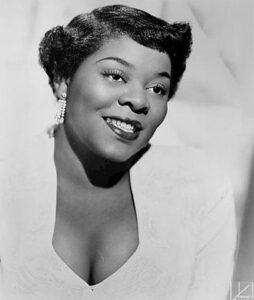Women’s History Month
Music Majesty
 Dinah Washington (1924-1963) was a singer and pianist, widely known as “the most popular black female recording artist of the ’50s”. Primarily a jazz vocalist, she performed and recorded in a wide variety of styles including blues, R&B, and traditional pop music, and earned her the title of “Queen of the Blues”. She was inducted into the Rock and Roll Hall of Fame in 1993. After winning a talent contest at the age of 15, she began performing in various clubs around Chicago until she was discovered by renowned bandleader Lionel Hampton, who stopped in to hear her. She began traveling with him as the lead vocalist for his band. In l946, she signed her first major record deal with Mercury Records and her first record for the label was a hit, ‘Ain’t Misbehavin.’
Dinah Washington (1924-1963) was a singer and pianist, widely known as “the most popular black female recording artist of the ’50s”. Primarily a jazz vocalist, she performed and recorded in a wide variety of styles including blues, R&B, and traditional pop music, and earned her the title of “Queen of the Blues”. She was inducted into the Rock and Roll Hall of Fame in 1993. After winning a talent contest at the age of 15, she began performing in various clubs around Chicago until she was discovered by renowned bandleader Lionel Hampton, who stopped in to hear her. She began traveling with him as the lead vocalist for his band. In l946, she signed her first major record deal with Mercury Records and her first record for the label was a hit, ‘Ain’t Misbehavin.’
Washington was at once one of the most beloved and controversial singers of the mid-20th century. Washington, who was married six times, was well-known for singing torch songs. She died at the age of 39, and an autopsy later showed that a lethal combination of secobarbital and amobarbital, prescription drugs for her insomnia, and diet contributed to her death. In 1959, she won a Grammy Award for her hit, ‘What A Difference A Day Makes.’ Recordings by Dinah Washington were inducted into the Grammy Hall Of Fame, which is a special Grammy award established in 1973 to honor recordings that are at least twenty-five years old, and that have “qualitative or historical significance. Click above photo to hear her sing.
 Eleanora Fagan (1915-1959) known professionally as Billie Holiday, was a jazz singer with a career spanning 26 years. Nicknamed “Lady Day” by her friend and music partner Lester Young, Holiday had an innovative influence on jazz music and pop singing. After a turbulent childhood, Holiday began singing in nightclubs in Harlem, where she was heard by producer John Hammond, who commended her voice. She signed a recording contract with Brunswick in 1935. Collaborations with Teddy Wilson yielded the hit “What a Little Moonlight Can Do,” which became a jazz standard. Throughout the 1930s and 1940s, Holiday had mainstream success on labels such as Columbia and Decca. By the late 1940s, however, she was beset with legal troubles and drug abuse.
Eleanora Fagan (1915-1959) known professionally as Billie Holiday, was a jazz singer with a career spanning 26 years. Nicknamed “Lady Day” by her friend and music partner Lester Young, Holiday had an innovative influence on jazz music and pop singing. After a turbulent childhood, Holiday began singing in nightclubs in Harlem, where she was heard by producer John Hammond, who commended her voice. She signed a recording contract with Brunswick in 1935. Collaborations with Teddy Wilson yielded the hit “What a Little Moonlight Can Do,” which became a jazz standard. Throughout the 1930s and 1940s, Holiday had mainstream success on labels such as Columbia and Decca. By the late 1940s, however, she was beset with legal troubles and drug abuse.
After a short prison sentence, she performed at a sold-out concert at Carnegie Hall, but her reputation deteriorated because of her drug and alcohol problems. She was a successful concert performer throughout the 1950s with two further sold-out shows at Carnegie Hall. Because of personal struggles and an altered voice, her final recordings were met with mixed reactions but were mild commercial successes. Her final album, Lady in Satin, was released in 1958. Holiday died of cirrhosis on July 17, 1959, at age 44. She won four Grammy Awards, all of them posthumously, for Best Historical Album. She was also inducted into the Grammy Hall of Fame. Click the above photo to hear her sing.
 Eunice Kathleen Waymon (1933-2003), known professionally as Nina Simone, was an American singer, songwriter, musician, arranger, and civil rights, activist. Her music spanned a broad range of musical styles including classical, jazz, blues, folk, R&B, gospel, and pop. The sixth of eight children born to a poor family in Tryon, North Carolina, Simone initially aspired to be a concert pianist. With the help of a few supporters in her hometown, she enrolled in the Juilliard School of Music in New York City. She then applied for a scholarship to study at the Curtis Institute of Music in Philadelphia, where she was denied admission despite a well-received audition, which she attributed to racial discrimination. In 2003, just days before her death, the Institute awarded her an honorary degree.
Eunice Kathleen Waymon (1933-2003), known professionally as Nina Simone, was an American singer, songwriter, musician, arranger, and civil rights, activist. Her music spanned a broad range of musical styles including classical, jazz, blues, folk, R&B, gospel, and pop. The sixth of eight children born to a poor family in Tryon, North Carolina, Simone initially aspired to be a concert pianist. With the help of a few supporters in her hometown, she enrolled in the Juilliard School of Music in New York City. She then applied for a scholarship to study at the Curtis Institute of Music in Philadelphia, where she was denied admission despite a well-received audition, which she attributed to racial discrimination. In 2003, just days before her death, the Institute awarded her an honorary degree.
To make a living, Simone started playing piano at a nightclub in Atlantic City. She changed her name to “Nina Simone” to disguise herself from family members, having chosen to play “the devil’s music” or so-called “cocktail piano.” She was told in the nightclub that she would have to sing to her own accompaniment, which effectively launched her career as a jazz vocalist. She went on to record more than 40 albums between 1958 and 1974, She had a hit single in the United States in 1958 with “I Loves You, Porgy.” Her musical style fused gospel and pop with classical music, in particular Johann Sebastian Bach, and accompanied expressive, jazz-like singing in her contralto voice. Click the above photo to hear her sing.






